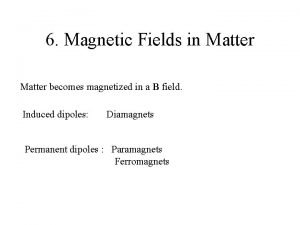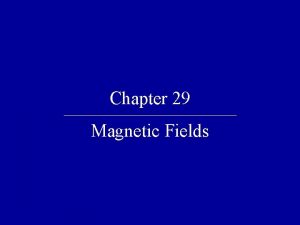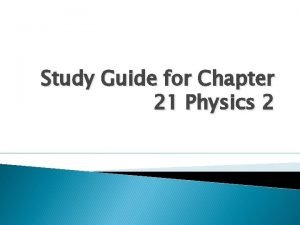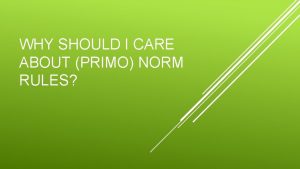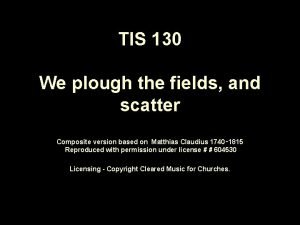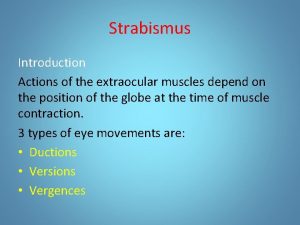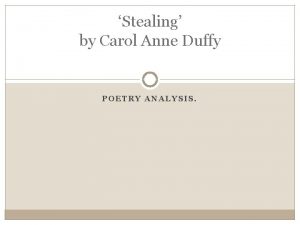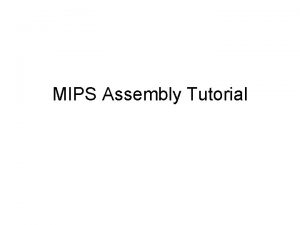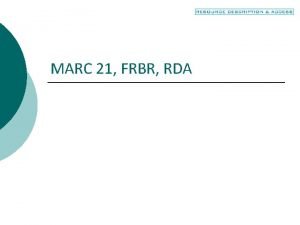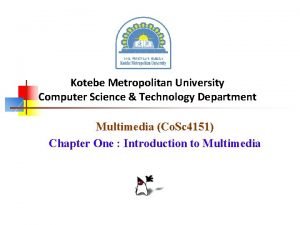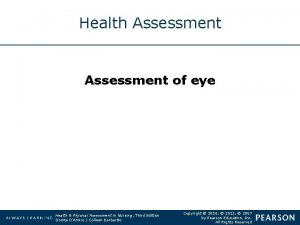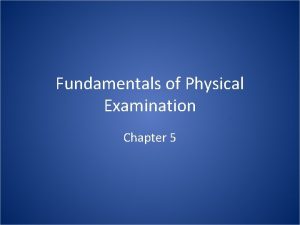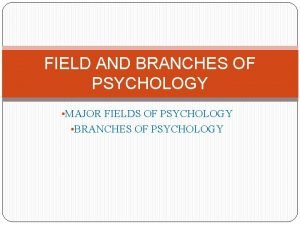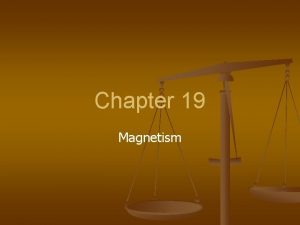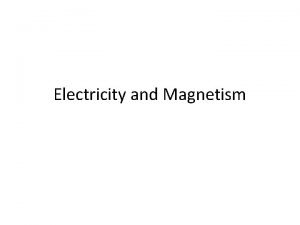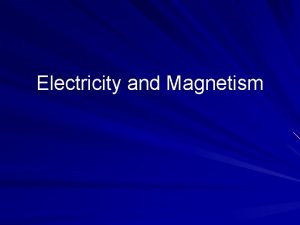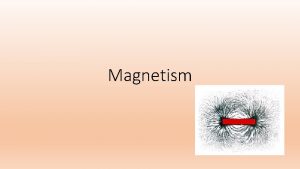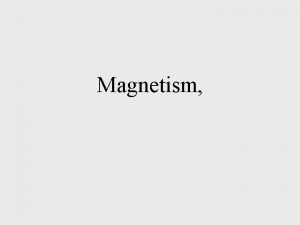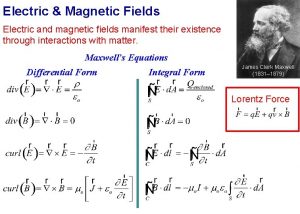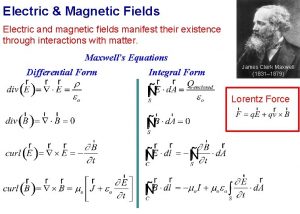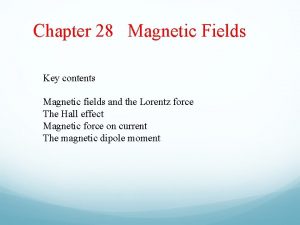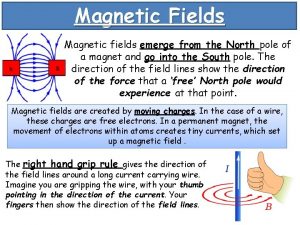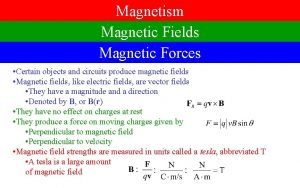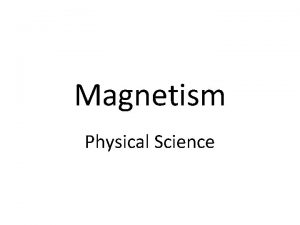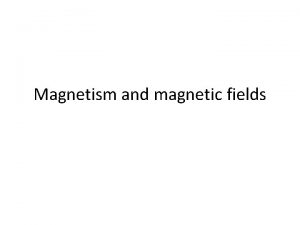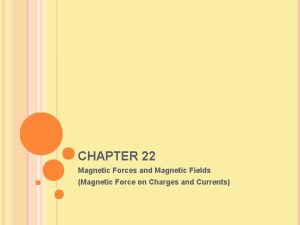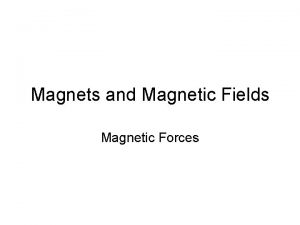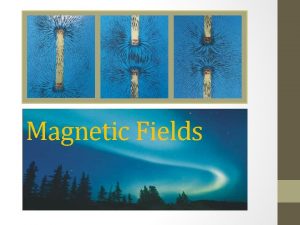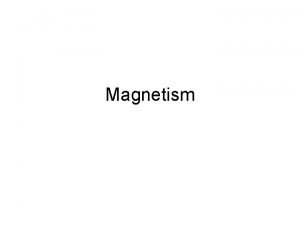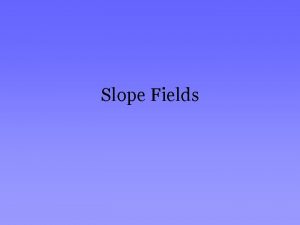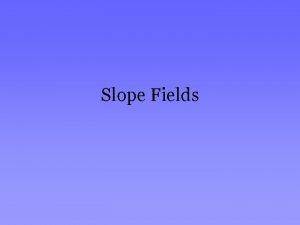Magnetism Magnetism Is the study of magnetic fields






































































- Slides: 70

Magnetism

Magnetism • Is the study of magnetic fields and their effect on materials. • The effect is due to unbalanced spin of electrons in atom. • It is readily observed every day – from the simple magnet that attracts nails and other metals to cassette tapes to magnet-driven trains.

Magnetism • In terms of applications, magnetism is one of the most important fields in physics. • Large electromagnets are used to pick up heavy loads. • Magnets are used in such devices as meters, motors, and loudspeakers. • Magnetic tapes and disks are used routinely in sound-and video-recording equipment and to store computer data. • Intense magnetic fields are used in magnetic resonance imaging (MRI) devices to explore the human body with better resolution and greater safety than x-rays can provide.

Magnetism • Giant superconducting magnet are used in the cyclotrons that guide particles into targets at nearly the speed of light. • Magnetism is closely linked with electricity. • Magnetic fields affect moving charges, and moving charges produce magnetic fields. • Changing magnetic field can even create electric fields. • These phenomena signify an underlying unity of electricity and magnetism, which James Clerk Maxwell first described in the 19 th century. • The ultimate source of any magnetic field is electric current.

Nature of Magnetism • In the ancient country of Lydia, in western Asia Minor, now Turkey, was a city called Magnesia. • The Greeks discovered that certain iron ores found in the place could attract other pieces or iron, they called it magnetites. • Magnetites are classified as natural magnet.

Nature of Magnetism It is now believed that magnetism is due to the spin of electrons within the atoms. Since the electron is a charged particle, the concept implies that magnetism is a property of a charged particle in motion.

Nature of Magnetism • The power of attraction of a magnet depends on the arrangement of the atoms. • All atoms are in themselves tiny magnet formed into groups called DOMAINS. • The magnetic strength is increased if the domains are induced to fall into line by the action of another magnet.

General Properties of Magnet • The properties of naturally occurring magnets (magnetites) have been known for over 2, 000 years. • Several studies on magnetism were made, but the first thorough investigation was done by William Gilbert in 1600. • Experimental results led to the discovery of the many properties of natural and artificial magnets.

General Properties of Magnet 1. Magnets usually have two poles. • The end of the magnet which points north when magnet is free to turn on a vertical axis is the north-seeking pole, simply the N pole.

General Properties of Magnet • The opposite end which points south is the south-seeking pole or S pole. • Magnets come in many shapes and sizes, but each has at least two poles. • If you cut a magnet into pieces, every piece will still have at least two poles.

General Properties of Magnet 2. Like Magnetic poles repel and unlike poles attract.

General Properties of Magnet Charles Augustine de Coulomb, a French physicist, was the first recognized scientist to study quantitatively the force exerted by magnets. The result of his experiments are summarized in what is known as Coulomb’s Law of Magnetism: “The force of attraction/repulsion between two magnetic poles is directly proportional to the strength of the poles and inversely proportional to the square of the distance between them”.

The result of his experiments are summarized in what is known as Coulomb’s Law of Magnetism: “The force of attraction/repulsion between two magnetic poles is directly proportional to the strength of the poles and inversely proportional to the square of the distance between them”.

Coulomb’s Law • In the MKS system of units, the unit of charge is the coulomb, the force is expressed in newtons and the distance in meter. • A coulomb is a very large unit of charge. A smaller unit is the statcoulomb. Ø 1 coul = 3 x 109 statcoul Ø 1 coul = 106 microcoul

Coulomb’s Law • Experiments have been undertaken to calculate the approximate value of k. This was found to be: • The smallest quantity of charge is the charge on the electron. This is called electronic charge. • Robert Millikan was able to obtain the value of this charge to be e = 1. 6 x 10 -19 coul. • This is also the charge of proton.

Problems to Illustrate Coulomb’s Law

Problem # 1 Two point charges of 2. 5 x 10 -10 coul and -3. 0 x 10 -10 coul are 10 cm apart in air. Calculate the magnitude and direction of the force on each charge. 10 cm or. 10 m -3. 0 x 10 -10 coul 2. 5 x 10 -10 coul N. m 2 (-3. 0 x 10 -10 coul)(2. 5 x 10 -10 coul) F = 9 X 109 Coul 2 (. 10 m)2 F = -6. 75 x 10 -8 N

• The result (F= -6. 75 x 10 -8 N) means that: • F 12 has a magnitude of 6. 75 x 10 -8 N and is directed toward q 1. • F 21 has a magnitude of -6. 75 x 10 -8 N and is directed toward q 2. Therefore: F 12 = - F 21

Problem # 2 Calculate the force between two point charge of +4. 5 x 10 -6 coul and -5. 0 x 10 -6 coul which are 15 cm apart in air. Answer: - 9. 0 N The negative sign in the answer indicates that the force between the point charges is an attractive force.

Problem # 3 Given the three point charges q 1, q 2, and q 3 as shown in the figure. If q 1 = +1. 5 x 10 -6 coul, q 2 = +2. 5 x 10 -6 coul and q 3 = -2. 0 x 10 -6 coul and 300 , d 12 =10 cm, d 13 = 15 cm. Find: a) the force between q 1 and q 3 b)The resultant force on q 1 q 3 = -2. 0 x 10 -6 coul F 13 = ? Ø d 13 = 0. 15 m d 12 =0. 10 m F 12 =? q 1 = +1. 5 x 10 -6 coul q 2 = +2. 5 x 10 -6 coul

Solution: a) the force between q 1 and q 3 k (q 1 q 3) F 13 = r 2 F 13 = 9 x 109 N. m 2 / coul 2 (+1. 5 x 10 -6 coul) (-2. 0 x 10 -6 coul) F 13 = -1. 2 N (0. 15 m)2 The negative value of F 13 indicates an attractive force on q 1 due to q 3. k (q 1 q 2) F 12 = r 2 q 3 = -2. 0 x 10 -6 coul 9 x 109 N. m 2 / coul 2 (+1. 5 x 10 -6 coul) (-2. 0 x 10 -6 coul) (0. 01 m)2 F 12 = 3. 375 N The positive value of F 12 indicates a repulsive force on q 1 due to q 2. F 13 = ? F 12 = ? d 13 = 0. 15 m q 2 = +1. 5 x 10 -6 coul d 12 =0. 10 m q 1 = +1. 5 x 10 -6 coul

Solution: b)The resultant force on q 1 To find the resultant force (Fnet ) on q 1, add F 12 and F 13 vectorially. The sum of the x-component is: ∑X = -3. 375 N + 1. 2 cos 600 ∑X = -2. 775 The sum of the y-component is: ∑Y = -1. 2 sin 600 ∑X = 1. 039 FNet = ? 300 Fnet =√(-2. 775)2 + (1. 039)2 F 13 = 1. 2 N Fnet = 2. 96 N F 12 = -3. 375 N

Solve the following problems: 1. Find the force between two eqaul charges of 15 x 10 -8 coul if they are 20 cm apart in air. -3 5. 06 X 10 N 2. Find the magnitude and direction of the force in each of two charges of 3. 5 x 10 -6 coul and -2. 8 x 10 -6 coul, 10 cm apart. 8. 82 X 102 N, attractive 3. Find the magnitude and kind of force between two charges of 20 x 10 -6 coul which are 25 cm apart in air. 432 N, repulsive 4. A charge of 2. 8 x 10 -6 coul is at a distance of 12 cm from another charge of -8. 4 x 10 -6 coul. Find the magnitude and direction of the force on the first charge that is due to the second charge. +14. 7 N 5. An unknown charge is attracted by a force of 25 N when it is at a distance of 10 cm from another charge of 25 x 10 -6 coul. What is the magnitude of the un known charge? q 1 = 1. 11 x 10 -6 coul

General Properties of Magnet 3. A piece of magnetite, when made to hang and swing freely, would align itself with the magnetic field of the earth following a northsouth direction.

General Properties of Magnet 4. Permanent magnets are magnets made from alloys of cobalt and nickel. These magnets retain their magnetism for a long time.

General Properties of Magnet 5. Other metals like iron can be magnetized by Induction. When a piece of iron nails touches a permanent magnet, the nails becomes a magnet. It retains in this condition for as long as it is within the magnetic field. The nail is a temporary magnet and its magnetism is described as induced magnetism.

Magnetic Field of Force • Experiment show that a stationary charged particle doesn’t interact with a static magnetic field. • When a charged particle is moving through a magnetic field, however, a magnetic force acts on it. • The force has its maximum value when the charge moves in a direction perpendicular to the magnetic field line, decreases in value at other angles, and becomes zero when moves along the field of lines.

Magnetic Field of Force • Magnetic force on a moving charge is directed perpendicular to the magnetic field. • It is found experimentally that the strength of the magnetic force on the particle is proportional to the magnitude of the charge q, the magnitude of the velocity v, the strength of the external magnetic field B, and the sine of the angle between the direction of v and the direction of B. F = qv. B sin θ • This expression is used to define the magnitude of the magnetic field as: F B = qv sin θ

Earth’s Magnetic Field • A small bar magnet is said to have north and south poles, but is it more accurate to say it has a “north-seeking” pole and “south-seeking” pole. • By this expressions, we mean that if such a magnet is used as a compass, one end will “seek” or point to, the geographic North Pole of Earth and the other end will “seek” or point to, the geographic South Pole of Earth.

Earth’s Magnetic Field • We therefore conclude that: The Geographic North Pole of Earth corresponds to a magnetic south pole, and the geographic South Pole of Earth corresponds to a magnetic north pole.

Earth’s Magnetic Field • The magnetic field pattern of Earth is similar to the pattern that would be set up by a bar magnet placed at its center. • An interesting fact concerning Earth’s magnetic field is that its direction reverses every few million years.

Earth’s Magnetic Field and its Present Application – Labeling Airport Runways • The magnetic field of Earth is used to label runways at airports according to their direction. • A large number is painted on the end of the runway so that it can be read by the pilot of an incoming airplane.

Earth’s Magnetic Field and its Present Application – Labeling Airport Runways • This number describes the direction in which the airplane is traveling, expressed as the magnetic heading, in degrees measured clockwise from magnetic north divided by 10. • A runway marked 9 would be directed toward the east (900 divided by 10), whereas a runway marked 18 would be directed toward magnetic south.

Magnetic Field of Force • If F is in newton, q in coulombs, and v in meter per second, the SI unit of magnetic field is the tesla (T), also called the weber (Wb) per square meter (1 T = 1 Wb/m 2). • The unit of B is: B = T = Wb/m 2 = N/C. m/s = N/A. m • The cgs unit of magnetic field is the gauss (G). 1 T = 104 G

Magnetic Field of Force • From equation F=qv. B sin θ, we see that the force on a charged particle moving in a magnetic field has its maximum value when the particle’s motion is perpendicular to the magnetic field, corresponding to θ=900 , so that sin θ = 1. • The magnitude of this maximum force has the value: Fmax = qv. B • Experiment also show that the direction of the magnetic force is always perpendicular to both v and B. To determine the direction of force, we employ the right-hand rule # 1.

Right-Hand Rule #1 The implications of this expression include: 1. The force is perpendicular to both the velocity v of the charge q and the magnetic field B. 2. The magnitude of the force is F = qv. B sinθ where θ is the angle < 180 degrees between the velocity and the magnetic field. This implies that the magnetic force on a stationary charge or a charge moving parallel to the magnetic field is zero. 3. The direction of the force is given by the right hand rule.

Right-Hand Rule # 1 Right-Hand Rule #1 determines the directions of magnetic force, conventional current and the magnetic field. Given any two of these, the third can be found. Using your right-hand: 1. point your index finger in the direction of the charge's velocity, v, (recall conventional current). 2. Point your middle finger in the direction of the magnetic field, B. 3. Your thumb now points in the direction of the magnetic force, Fmagnetic.

Right-Hand Rule # 1 When the magnetic force relationship is applied to a current-carrying wire, the right-hand rule may be used to determine the direction of force on the wire.

Right-Hand Rule # 2 Right-Hand Rule #2 determines the direction of the magnetic field around a current-carrying wire and vice-versa Using your right-hand: Curl your fingers into a half-circle around the wire, they point in the direction of the magnetic field, B Point your thumb in the direction of the conventional current.

Problem • A proton moves with a speed of 1. 00 x 105 m/s through Earth’s magnetic field, which has a value of 55. 0µT at a particular location. When the proton moves eastward, the magnetic force acting on it is directed straight upward, and when it moves northward, no magnetic force act on it. a) What is the direction of the magnetic field? b) What is the strength of the magnetic force when the proton moves eastward? c) Calculate the gravitational force on the proton and compare it with the magnetic force. If there were an electric field with a magnitude equal to E=1. 50 x 102 N/C at that location, a common value at Earth’s surface. Note the mass of the proton is 1. 67 x 10 -27 kg.

Solution: a) What is the direction of the magnetic field? No magnetic force act on the proton when it’s going North, so the angle such a proton makes with the magnetic field direction must be either o 0 or 1800. Therefore, the magnetic field B must point either north or south. Now apply the right hand rule. When the particle travels east, the magnetic force is directed upward. Point your thumb in the direction of the force and your finger in the direction of the velocity eastward. When you curl your finger, they point north, which must therefore be the direction of the magnetic field.

Solution a) What is the strength of the magnetic force when the proton moves eastward? Substitute the given values and the charge of a proton into equation F=qv. B sin θ. From part (a), the angle between the velocity v of the proton and magnetic field B is 900 F= qv. B sin θ F= (1. 60 x 10 -19 C)(1. 00 X 105 m/s) x (55. 0 x 10 -6 T) sin (900 ) F= 8. 80 x 10 -19 N

Solution: Calculate the gravitational force on the proton and compare it with the magnetic force and also with the electric force if E=1. 50 X 102 N/C. Fgrav. = mg = (1. 67 x 10 -27 kg. ) (9. 8 m/s 2 ) = 1. 64 x 10 -26 N Felec = q. E = (1. 60 x 10 -19 C) (1. 50 X 102 N/C) = 2. 40 X 10 -17 N

Problem # 2 A Proton Moving in a Magnetic Field A proton moves at 8. 00 x 106 m/s along the x-axis. It enters a region in which there is a magnetic field of magnitude 2. 50 T, directed at an angle of 600 with the x-axis and lying in the xy-plane. a)Find the initial magnitude and direction of the magnetic force on the proton. b) Calculate the proton’s initial acceleration. Hint: Finding the magnitude and direction of the magnetic force requires substituting values into the equation for magnetic force, (a) (F=qv. B sin θ), and using the righthand rule. (b)Applying Newton’s second law.

Solution: a) Find the magnitude and direction of the magnetic force on the proton. F=qv. B sin θ = (1. 60 x 10 -19 C) (8. 00 X 106 m/s) (2. 50 T) (sin 600) = 2. 77 x 10 -12 N Point the fingers of the right hand in the x-direction (direction of v) and then curl them toward B. The thumb points (upward, in the positive z-direction.

Solution: b) Calculate the proton’s initial acceleration. am = F (1. 67 X 10 -27 kg) ( a ) = 2. 77 x 10 -12 N a = 1. 66 x 1015 m/s 2

Magnetic Force on a Current. Carrying Conductor • If a straight conductor of length ℓ carries current, the magnetic force on that conductor when it is placed in a uniform external magnetic field B is: F = BIℓ sin θ • Where Ø Ɵ is the angle between the direction of the current and the direction of the magnetic field. Ø B is the direction of the current. Ø I is the current Ø ℓ is the length of the wire

Magnetic Force on a Current. Carrying Conductor • Right-hand rule #1 also gives the direction of the magnetic force on the conductor. In this case, however, you must point your fingers in the direction of the current rather than in the direction of v.

Application: • A magnetic force acting on a current-carrying wire in a magnetic field is the operating principle of most speakers in sound systems.

Application: • Speaker is consists of a coil of wire called the voice coil, a flexible paper cone that acts as the speaker, and a permanent magnet. • The coil of wire is surrounding the north pole of the magnet is shaped so that the magnetic field lines are directed radially outward from the coil’s axis. • When an electrical signal is sent to the coil, producing a current in the coil, a magnetic force to the left acts on the coil. (can be seen by applying right-hand rule #1 to each turn of wire).

Application: • When the current reverses direction, as it would for a current that varied sinusoidally, the magnetic force on the coil also reverses direction, and the cone, which is attached to the coil, accelerates to the right. • An alternating current through the coil causes an alternating force on the coil, which results in vibrations of the cone. • The vibrating cone creates sound waves as it pushes and pulls on the air in front of it. • In this way, a 1 -k. Hz electrical signal is converted to a 1 -k. Hz sound waves.

Additional Research Work • Research on the other application of currentcarrying conductors, and explain how it works. • What is electromagnetic pumps (artificial heart and kidney). Explain how current-carrying conductors is applied in the manufacture of electromagnetic pump.

Problem: • A wire carries a current of 22. 0 A from west to east. Assume the magnetic field of Earth at this location is horizontal and directed from south to north and it has a magnitude of 0. 500 x 10 -4 T. • a) Find the magnitude and direction of the magnetic force on a 36. 0 -m long of wire. • b) Calculate the gravitational force on the same length of wire if it’s made of copper and has a cross-sectional area of 2. 50 x 10 -6 m 2.

Solution: • a) Find the magnitude and direction of the magnetic force on a 36. 0 -m long of wire. F = BIℓ sin θ = (0. 500 x 10 -4 T) (22. 0 A) (36. 0 m) sin 900 = 3. 96 x 10 -2 N Applying the right-hand rule #1 to find the direction of the magnetic force: With fingers of your right hand pointing west to east in the direction of the current, curl them north in the direction of the magnetic field. Your thumb points UPWARD.

Solution: • b) Calculate the gravitational force on the same length of wire if it’s made of copper and has a cross-sectional area of 2. 50 x 10 -6 m 2. Density of the metal • m= ρv = ρ(Aℓ) =8. 92 x 103 (2. 50 x 10 3 kg. m ) -6 m 2. 36. 0 m) = 0. 803 kg • To get the gravitational force, multiple the mass by the acceleration of gravity: • Fgrav. = mg = (0. 803 kg) (9. 8 m/s 2) = 7. 87 N

Torque on a Current Loop and Electric Motor • The torque Ƭ on a current-carrying loop of wire in a magnetic field B has magnitude: Ƭ = BIA sin θ • Where: Ø I is the current in the loop Ø A is the cross-sectional area • The magnitude of the magnetic moment of the current-carrying coil is defined by µ = IAN Ø N is the number of loops • The magnetic moment is considered vector, µ, that is perpendicular to the plane of the loop. • The angle between B and µ is θ.

Problem: • A circular wire loop of radius 1. 00 m is placed in a magnetic field of magnitude 0. 500 T. The normal to the plane of the loop makes an angle of 30. 00 with the magnetic field. (see Illustration) The current in the loop is 2. 00 A in the direction shown. • a) Find the magnetic moment of the loop and the magnitude of the torque at this instant. • b) The same current is carried by the rectangular 2. 00 -m by 3. 00 -m coil with three loops. Find the magnetic moment of the coil and the magnitude of the torque acting on the end of the coil at that instant.

Solution: • a) Find the magnetic moment of the circular loop and the magnetic torque exerted on it. • Hint: Ø First, calculate the enclosed area of the circular loop. Ø Calculate the magnetic moment of the loop Ø Substitute values for the magnetic moment, magnetic field, and θ into Ƭ = µB sin θ A = ╥r 2 = 1. 00 m)2 = 3. 14 m 2 µ = IAN = (2. 00 A) (3. 14 m 2) (1) = 6. 28 A. m 2 Ƭ = µb sin θ = (6. 28 A. m 2) (0. 500 T) (sin 30. 00) = 1. 57 N. m

Solution: • Find the magnetic moment of the rectangular coil and the magnetic torque exerted on it. • Hint: Ø Calculate the area of the coil. Ø Calculate the magnetic moment of the coil Ø Substitute values into equation Ƭ = µB sin θ A= L x H = (2. 00 m) (3. 00 m) = 6. 00 m 2 µ= IAN = (2. 00 A) (6. 00 m 2) (3) = 36. 0 A. m 2 Ƭ = µb sin θ = (. 500 T) (36. 0 A. m 2) (sin 300) = 9. 00 N. m

Application: • Its hard to imagine life in the 21 st century without motors. • Some of the appliances that contain motors include computer disk drives, CD players, DVD players, food processors and blenders, car starters, furnaces, and air conditioners. • The motors convert electrical energy to kinetic energy of rotation and consist of a rigid current-carrying loop that rotates when placed in the field of a magnet.

Magnetic Field of a Long, Straight Wire During the lecture demonstration in 1819, Danish Scientist Hans Oersted found than an electric current in a wire deflected a nearby compass needle. This momentous discovery, linking a magnetic field with an electric current for the first time, was the beginning of our understanding of the origin of magnet.

Magnetic Field of a Long, Straight Wire • In the simple experiment carried by Oersted in 1820, several compass needles are placed in a horizontal plane near a long vertical wire.

Magnetic Field of a Long, Straight Wire • When there is no current in the wire, all needles point in the same direction (that of Earth’s field), as one would expect. • When the wire carries a strong, steady current, however, the needles all deflect in directions tangent to the circle.

Magnetic Field of a Long, Straight Wire • The observation of Oersted show that the direction of B is consistent with the following convenient rule, Right-Hand Rule # 2.

Magnetic Field of a Long, Straight Wire • The magnetic field at distance ṙ from along, straight wire carrying current I has the magnitude: B= µ 0 I 2╥ṙ • Where; Ø µ 0 = 4╥ X 10 -7 T. m/A is the permeability of free space Ø The magnetic field lines around a long, straight line wire are circles concentric with the wire.

Magnetic Field of a Long, Straight Wire • Ampere’s law can be used to find the magnetic field around certain simple current-carrying conductors. It can be written: ∑Bǁ ∆ℓ = µ 0 I • Where: Ø Bǁ is the component B tangent to a small current element of length ∆ℓ that is part of a closed path and I is the total current that penetrates the closed path.

Sample Problem: • A coaxial cable consists of an insulated wire carrying current I 1 = 3. 00 A surrounded by a cylindrical conductor carrying current I 2 = 1. 00 A in the opposite direction. ( see illustration) a) calculate the magnetic field inside the cylindrical conductor at rint = 0. 500 cm. Calculate the magnetic field outside the cylindrical conductor at rext = 1. 50 cm.

Solution: • a) Calculate the magnetic field Bint inside the cylindrical conductor at rint = 0. 500 cm. • Hint: Ø Write the Ampere’s law Ø The magnetic field is constant on the given path and the total path length is 2╥ṙint : Ø Solve for Bint and substitute values: ∑Bǁ ∆ℓ = µ 0 I Bint =(2╥ṙint )= µ 0 I 1 Bint = µ 0 I 1 2╥ṙint (4╥ x 10 -7 T. m/A) (3. 00 A) = 2╥ (0. 005 m) = 1. 20 x 10 -4 T

Solution: • b) Calculate the magnetic field Bext outside the cylindrical conductor at rext = 1. 50 cm. • Hints: Ø Write the Ampere’s law Ø The magnetic field is again constant on the given path and the totla path length is 2╥rext Ø Solve for Bext and sustitute values ∑Bǁ ∆ℓ = µ 0 I Bext (2╥ṙext )= µ 0(I 1 – I 2) (4╥ X 10 -7 T. m/A) (3. 00 A – 1. 00 Bext = A) 2╥ṙext 2╥ (0. 015 m) = 2. 64 x 10 -5 T

 Red fields
Red fields Learning: module 26: magnetic forces and fields
Learning: module 26: magnetic forces and fields Scrap heap magnet circuit diagram
Scrap heap magnet circuit diagram Magnetic field in matter
Magnetic field in matter Lesson quiz 29-1
Lesson quiz 29-1 Electric currents and magnetic fields
Electric currents and magnetic fields Electric currents and magnetic fields
Electric currents and magnetic fields Chapter 24 magnetism magnetic fundamentals answers
Chapter 24 magnetism magnetic fundamentals answers Remanent magnetization
Remanent magnetization Flux in weber
Flux in weber Magnetic moment and magnetic field relation
Magnetic moment and magnetic field relation Magnetic field and magnetic force
Magnetic field and magnetic force Physics chapter 21 study guide answers
Physics chapter 21 study guide answers Hình ảnh bộ gõ cơ thể búng tay
Hình ảnh bộ gõ cơ thể búng tay Ng-html
Ng-html Bổ thể
Bổ thể Tỉ lệ cơ thể trẻ em
Tỉ lệ cơ thể trẻ em Gấu đi như thế nào
Gấu đi như thế nào Thang điểm glasgow
Thang điểm glasgow Chúa yêu trần thế alleluia
Chúa yêu trần thế alleluia Các môn thể thao bắt đầu bằng tiếng nhảy
Các môn thể thao bắt đầu bằng tiếng nhảy Thế nào là hệ số cao nhất
Thế nào là hệ số cao nhất Các châu lục và đại dương trên thế giới
Các châu lục và đại dương trên thế giới Công thức tính độ biến thiên đông lượng
Công thức tính độ biến thiên đông lượng Trời xanh đây là của chúng ta thể thơ
Trời xanh đây là của chúng ta thể thơ Cách giải mật thư tọa độ
Cách giải mật thư tọa độ Phép trừ bù
Phép trừ bù độ dài liên kết
độ dài liên kết Các châu lục và đại dương trên thế giới
Các châu lục và đại dương trên thế giới Thơ thất ngôn tứ tuyệt đường luật
Thơ thất ngôn tứ tuyệt đường luật Quá trình desamine hóa có thể tạo ra
Quá trình desamine hóa có thể tạo ra Một số thể thơ truyền thống
Một số thể thơ truyền thống Cái miệng nó xinh thế
Cái miệng nó xinh thế Vẽ hình chiếu vuông góc của vật thể sau
Vẽ hình chiếu vuông góc của vật thể sau Thế nào là sự mỏi cơ
Thế nào là sự mỏi cơ đặc điểm cơ thể của người tối cổ
đặc điểm cơ thể của người tối cổ Giọng cùng tên là
Giọng cùng tên là Vẽ hình chiếu đứng bằng cạnh của vật thể
Vẽ hình chiếu đứng bằng cạnh của vật thể Fecboak
Fecboak Thẻ vin
Thẻ vin đại từ thay thế
đại từ thay thế điện thế nghỉ
điện thế nghỉ Tư thế ngồi viết
Tư thế ngồi viết Diễn thế sinh thái là
Diễn thế sinh thái là Dot
Dot So nguyen to
So nguyen to Tư thế ngồi viết
Tư thế ngồi viết Lời thề hippocrates
Lời thề hippocrates Thiếu nhi thế giới liên hoan
Thiếu nhi thế giới liên hoan ưu thế lai là gì
ưu thế lai là gì Khi nào hổ con có thể sống độc lập
Khi nào hổ con có thể sống độc lập Khi nào hổ mẹ dạy hổ con săn mồi
Khi nào hổ mẹ dạy hổ con săn mồi Hệ hô hấp
Hệ hô hấp Từ ngữ thể hiện lòng nhân hậu
Từ ngữ thể hiện lòng nhân hậu Thế nào là mạng điện lắp đặt kiểu nổi
Thế nào là mạng điện lắp đặt kiểu nổi Norm rule fields
Norm rule fields How many fields in computer science
How many fields in computer science Electric forces and fields concept review
Electric forces and fields concept review All good gifts around us are sent from heaven above
All good gifts around us are sent from heaven above The apices of the lungs
The apices of the lungs Latent strabismus
Latent strabismus 6 cardinal fields of gaze
6 cardinal fields of gaze Stealing carol ann duffy analysis
Stealing carol ann duffy analysis Slope fields ap calculus
Slope fields ap calculus New consultant training
New consultant training Mips fields
Mips fields Rda fields
Rda fields Kotebe metropolitan university website
Kotebe metropolitan university website Six cardinal fields of gaze
Six cardinal fields of gaze Egophony
Egophony Branches of social psychology
Branches of social psychology



